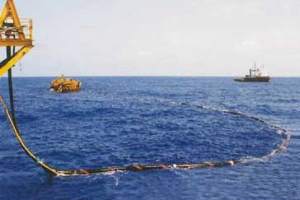NETHERLANDS: First integral floating production line
April 2001 Vol. 222 No. 4 Feature Article THE NETHERLANDS: First integral floating production line With hundreds of marginal offshore oil fields waiting fo
THE NETHERLANDS:First integral floating production lineWith hundreds of marginal offshore oil fields waiting for exploitation, low investment and production costs are a key factor in the go/no-go decision. A remarkable solution was created by FPS (Houston, USA) and realized at the Didon project (M.P. Zarat, Tunisia). The field produces about 6,000 bpd sour crude with gas (900 ppm H2S) at 212°F (100°C). The key element is a high-pressure floating-production line, which connects the FPSO and a catenary-anchored-leg mooring buoy (see figure). An umbilical for well control is piggybacked on the flexible production line. The buoy is equipped with a high-pressure swivel for the production line
Previously, the operator had faced serious problems. The first production line was installed with solid floaters clamped both to the line and the umbilical. After relatively short operation, the floaters started to move under wave impact, and the rubber cover was torn, exposing reinforcing cables directly to seawater. The operator experimented with other high-pressure hoses, but the lines failed. Hungary’s Taurus Emergé was contacted, and the company took a different approach. Various solutions were analyzed. For example: a single piece of 500-ft (150-m) bonded-construction line with reinforced cover; a shorter line with replaceable sacrificial hoses at both ends; and an integral floating-production line. Considering weather conditions and available installation equipment, it was decided to use an integral floating, fully bonded (rubber) production line, with limited individual segment length. The final parameters were: design pressure of 2,500 psi (17.3 MPa); working pressure about 1,400 psi (10 MPa); 3-in. ID; overall 500-ft length; 9 pieces of 50-ft (15-m), integrally floating hoses; and two, reinforced, non-floating end pieces, each 25-ft (7.5-m) long. Both hoses (main and end pieces) are steel-cable reinforced rubber of bonded structure. The non-floating segments were designed to withstand the highest stresses arising at the ends of the line. These hoses have high axial and bending stiffness plus more built-in bend stiffener at the end fitting. Built-in plastic-foam layers assured buoyancy of the mainline hoses. Hose properties were carefully checked by finite element modeling. Static and dynamic analysis of the hose line was conducted, including storm conditions, full or ballasted FPSOs, etc. While carrying out hydrodynamic simulations, configuration of the entire system (i.e., line length, linking chain locations and lengths, orientation of end connections at buoy side, etc.) was modified. Due to these changes, peak forces and moments acting on hoses and other system components were significantly reduced. Line configuration and hose construction proved suitable, and the system has been in continuous operation for the past two years, having survived the worst storm in 10 years. This was the first integral floating, high-pressure flexible line for crude oil and gas service. Thanks to the successful design, the operator ordered another production line of similar type. This approach is unique worldwide and a cost-effective solution for marginal-field production. Editor’s note: As of May 1, 2001, Taurus Emergé
Rubber Industrial Ltd., a member of the Phoenix Group, will continue its activities under a new name, Phoenix
Rubber Industrial Ltd.
|
- Applying ultra-deep LWD resistivity technology successfully in a SAGD operation (May 2019)
- Adoption of wireless intelligent completions advances (May 2019)
- Majors double down as takeaway crunch eases (April 2019)
- What’s new in well logging and formation evaluation (April 2019)
- Qualification of a 20,000-psi subsea BOP: A collaborative approach (February 2019)
- ConocoPhillips’ Greg Leveille sees rapid trajectory of technical advancement continuing (February 2019)



